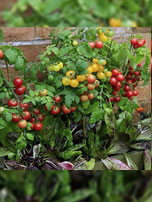Raktaphala

Botanical Name : Solanum lycopersicum
Family : Solanaceae
Introduction :
Tomato, flowering plant of the nightshade family (Solanaceae), cultivated extensively for its edible fruits. Labelled as a vegetable for nutritional purposes, tomatoes are a good source of vitamin C and the phytochemical lycopene. The fruits are commonly eaten raw in salads, served as a cooked vegetable, used as an ingredient of various prepared dishes, and pickled.
Names in different Indian languages :
English : tomato
Hindi : tamatar
Malayalam : takkali
Sanskrit : raktaphala
Tamil : seemay tekkali
Synonyms :
Raktamaci, raktavardhak, belavaangi
Lycopersicon lycopersicum (L.) KARST.
Morphology :
This is an annual herb with indeterminate growth. It grows up to 1 m in height. The stem is much branched and prostrate, green with hairy surface. The leaves are compound, ovate, alternate, petiolate, up to 7.0 cm long and 4.0 cm wide, margin serrated, apex acute, base oblique.The fruit is a berry, deep green when immature, red when mature, up to 12 cm in diameter, flattened to slightly flattened, multilobed and strongly depressed, pistil scar irregular and blossom end shape indented.
Distribution & Habitat :
Throughout India
Chemical constituents :
Ascorbic acid, biotin, folic, nicotinic acid riboflavin
Properties :
Guns:lagu, snigdha
Rasa:madura, amla
Virya: ushna;
Vipaka:katu
Part used :
fruit
Uses :
Mild aperient, blood purifier, cholagogue, digestive. Used in homoeopathy for treating rheumatic conditions, colds, chills, digestive disorders, diabetes, obesity, leucorrhoea, metrorrhagia.
Tomato is a powerful deobstruent. It promotes flow of bile; mildly laxative, especially when taken raw. Tomato stimulates torpid liver and kidneys and helps to wash away toxins. Tomato is recommended for diabetics. It is a major dietary source of carotenoid lycopene.
Tomato juice inhibits carcinogenic N-nitrosocompound formation chiefly in the stomach. Most of the inhibition of formation of N-nitrosomorpholine by phenolic fraction of tomato juice was due to chlorogenic acids. The ascorbate fraction of the juice also contains compounds that inhibit nitrosation.
Consumption of tomato juice can significantly increase serum lycopene levels.